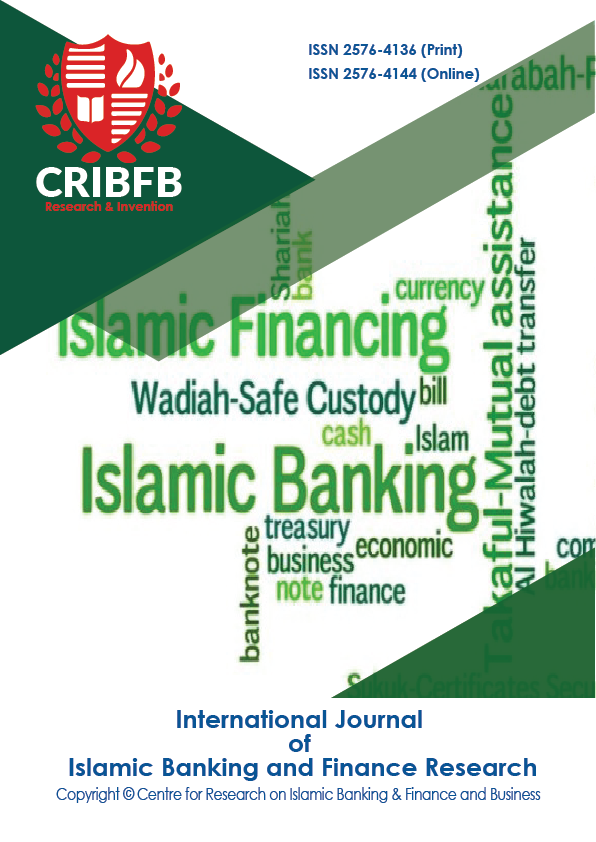ISLAMIC BANKING SYSTEM IN THE SULTANATE OF OMAN FROM THE PERSPECTIVE OF BANKING OFFICERS EMPLOYEES AND CUSTOMERS
Main Article Content
Abstract
This research aims to determine the viability for the operation of Islamic banks within the Omani banking system. By looking into various opportunities for Islamic banking in Oman and given the unique rules on transactions (fiqh muamalat) of Islamic banking based on the Shariah precepts or the so-called Islamic law. As the establishment of small and medium enterprises (SMEs) is rapidly growing in Oman, many SMEs can draw support from Islamic banks. The study used a mixed method approach to answer the research questions. Do the participants patronize Islamic banking over conventional banking?. The study compared both conventional and Islamic Banking. The population of the study represented bank officers, bank employees and customers. The sample of the study (n=100) participated in the survey. Another selected sample participated in interviews. Findings revealed different views over Islamic banking. Islamic banking is careful to provide products and services. Also, they are found to be capable of offering products and processes that answers the need of certain aspects with a risk management framework that is distinct from what normal banking provides. The study findings support the need for Islamic banking systems as it would be easier to spread Islamic banking and financing.
JEL Classification Codes: E5, E58, G2, G21, E4, E42.
Downloads
Article Details
Section
How to Cite
References
Al Bahar, A. A. (1999). "Islamic Finance and Investment: A New Era” Proceedings of the Second Harvard University Forum on Islamic Finance. Harvard University, 179-181, Center for Middle Eastern.
Al Baraka Banking Group. (2013). Islamic Banking. Retrieved from http://www.albaraka.com/default.asp?action=article&id=46
Al-Jarhi, A., & Iqbal, M. (2001). Islamic Banking: Answers to Some Frequently Asked Questions, Occasional paper No. 4 Islamic Islamic Development Bank , s.l.: Islamic Research and Training Institute. .
AMEInfo.com ( 2012). Fitch sees new Islamic banks in Oman to struggle, initially. Retrieved from http://www.ameinfo.com/fitch-islamic-banks-oman-struggle-initially-314145
Belwal, R., & Al Maqbali, A. (2019). A study of customers’ perception of Islamic banking in Oman. Journal of Islamic Marketing.
Dewi, M. K., & Ferdian, I. R. (2009) . Islamic Finance: A Therapy for Healing the Global Financial Crisis. Challenges of Globalising Financial System. Amman, Jordan: The Hashemite University.
Furqani, H., & Mulyany, R. (2009). Islamic banking and economic growth: Empirical evidence from Malaysia. Journal of Economic Cooperation & Development, 30(2), 59-74.
Hanif, M. (2011). Differences and Similarities in Islamic and Conventional Banking. International Journal of Business and Social Science, 2(2), 166-175.
Hasan, M., & Dridi, J. (2010). The Effects of the Global Crisis on Islamic an Conventional Banks: A Comparative Study IMF Working Paper., s.l.: IMF.
Kahf, M., Amad, A., & Homud, S. (1998). Islamic Banking and Development An alternative Banking Concept?. Retrieved from http://monzer.kahf.com/papers/english/Isbnk_and_dev_alternative_banking_concept.pdf
Kpodar, M. K., & Imam, P. A. (2010). Islamic banking: how has it diffused?. International Monetary Fund.
Lewis, M., & Algaoud, L. (2001). Islamic Banking. Cheltenham, UK: Edward Elgar.
Loghod, H. A. (2010). Do Islamic Banks Perform Better than Conventional Banks? Evidence from Gulf Cooperation Council countries. Retrieved from www.arab-api.org.
Magd, H. A., & McCoy, M. P. (2014). Islamic finance development in the sultanate of Oman: Barriers and recommendations. Procedia Economics and Finance, 15, 1619-1631.
Miles, M., & Huberman, A. (1994). Qualitative Data Analysis. 2nd ed. Thousand Oaks. CA: Sage.
Mubeen, S. A., Kulkarni, N. A., & Al Hussaini, Y. K. (2014). The future of Islamic banking in Sultanate of Oman. International Journal of Economics and Finance, 6(5), 203-209.
Muscat Daily Staff Writer (2013). OMAN SHOULD RESTRAIN SPENDING, INCREASE NON-OIL REVENUES: IMF. Retrieved from http://www.muscatdaily.com/Archive/Business/Oman-should-restrain-spending-increase-non-oil-revenues-IMF-2bws
Rettab, B., Kashani, H., Obay, L., & Rao, A. (2010). Impact of Market Power and Efficiency on Performance of Banks in the Gulf Cooperation Council Countries. International Research Journal of Finance and Economics, 50, 190-199.
Rizwan, R. (2021). Performance Comparison of Islamic Banks and Conventional Banks in Pakistan. International Journal of Islamic Banking and Finance Research, 5(1), 34-41.
Rosmanidar, E., Al Hadi, A. A., & Ahsan, M. (2021). Islamic Banking Performance Measurement: A Conceptual Review of Two Decades. International Journal of Islamic Banking and Finance Research, 5(1), 16-33.
Salim, B. F., & Al Ani, M. K. (2015). The Impact of Islamic Banking Challenges and Opportunities on the Market Share: Evidence from Oman. European Journal of Economics, Finance and Administrative Sciences, (76).
Shafique, A., Faheem, M. A., & Abdullah, I. ( 2012). Impact of Global Financial Crises on the Islamic Banking System Analysis of Islamic Financial System during Financial Crunch 2008. Arabian Journal of Business and Management Review (OMAN Chapter), 1(9), 124-134.
Siddiqi, M. (2004). Riba, Bank interest and the rationale of its prohibition, Jeddah: Islamic Research & Training Institute Jeddah.
Siddiqui, M. (1987). Partnership And Profit-Sharing In Islamic Law. Leicester,UK: The Islamic Foundation.
Usmani, M. (2002). Meezanbank’s Guide To Islamic Banking. Karachi, Pakistan: Darul-Ishaat.




